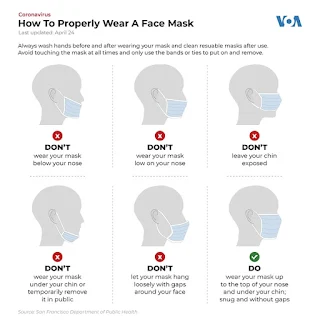Face Masking
Introduction
It used to be only during annual haze season, we will start wearing face mask. However, due to COVID-19, face masking has been part of our living norm. One does not feel safe if coming out of car without a face mask.
Wear the Correct Way
Face masking does not provide the protection if we did not wear it properly. Few key points should include
- The outer fabric of surgical face masks is usually yellow or blue with one elastic or wire edge for tightening.
- To put it on properly, the mask’s absorbent side must be worn facing in and the coloured side facing out.
- The mask needs to fit securely over the mouth, chin and nose. That is why the edge with the metal strip is put at the top - so that the metal can be moulded over the nose.
Double Masking
In May 2021, the Health director-general Tan Sri Dr Noor Hisham said that according to the US government's CDC, double-masking or wearing a cloth mask on top of a medical-grade mask helps filter more particles than wearing a single cloth mask alone.
Wearing two masks could make it more difficult to breathe, but double-masking (with a surgical and a cloth) is generally well-tolerated and doesn't reduce oxygen supply.
- A N95 remains the gold standard and it can seal the face and filter 95% of particles. So, no doubling up required.
NOTE: For N95 to function properly, it requires a tight-fitting with minimal leakage. In fact, facial hair ideally should be clean shaven to minimize the leakage risk when wearing N95 masks.
N95, KN95 and KF94 Masks
All face masks aren't equal and there's a difference between medical-grade respirators and cloth face coverings. However, it is quite confusing for public when comes to N95 masks, KN95 masks and KF94 masks.
N95 masks have been the mainstay of protection and they filter 95% as small as 0.3 microns in size. However, due to short supply of N95 masks, more and more people turned to two other popular mask types, KN95 and KF94.
- KN95 masks are considered to be the Chinese equivalent to N95 masks.
- "KF" in KF94 stands for "Korean Filter" and the "94" indicates a 94% filtration efficacy. KF94 is the South Korean equivalent to the N95 mask with few differences.
Theoretically, N95, KN95 or KF94 masks will provide better protection than any 3-ply or 4-ply surgical mask provided the seal is good.
Before answering any questions on protection efficacy, we shall first have some ideas about fit test and fit check.
Fit test
Fit test is conducted to verify that a respirator is both comfortable and correctly fits the user, because faces can vary widely in shape, size and proportion.
- Each fit test is only specific to that particular respiratory model for that particular individual.
It should be conducted annually and repeated whenever there is visual change in the physical condition (e.g. cosmetic surgery, facial scarring, dental changes) or change to the type or model of mask.
Fit test methods can be either
- Qualitative - relies on the individual's sensory detection of a test agent, such as taste, smell or involuntary cough; or
- Quantitative
Fit Check
Fit Check (or referred to as user seal check) is a procedure conducted by the respirator wearer to determine if the respirator is being properly worn. It should be completed each the respirator is donned.
It can either be
- Positive pressure check
- Once the particulate respirator is properly donned, place your hands over the facepiece, covering as much surface area as possible. Exhale gently into the facepiece. The face fit is considered satisfactory if a slight positive pressure is being built up inside the facepiece without any evidence of outward leakage of air at the seal.
- Examples of such evidence would be the feeling of air movement on your face along the seal of the facepiece, fogging of your glasses, or a lack of pressure being built up inside the facepiece.
- If the particulate respirator has an exhalation valve, then performing a positive pressure check may be impossible
- Negative pressure check
- Negative pressure seal checks are typically conducted on particulate respirators that have exhalation valves. To conduct a negative pressure user seal check, cover the filter surface with your hands as much as possible and then inhale.
- The facepiece should collapse on your face and you should not feel air passing between your face and the facepiece.
In the case of either type of seal check, if air leaks around the nose, use both hands to readjust the nosepiece by placing your fingertips at the top of the metal nose clip. Slide your fingertips down both sides of the metal strip to more efficiently mould the nose area to the shape of your nose. Readjust the straps along the sides of your head until a proper seal is achieved.
If you cannot achieve a proper seal due to air leakage, you may need to be fit tested for a different respirator model or size.
NOTE: A user fit check cannot be considered as a substitute for a fit testing, rather it leads to higher quality donning.
External Links
- 3M - FIT TEST VS FIT CHECK – UNDERSTANDING THE DIFFERENCE, 2020
- What doctors wish patients knew about double masking, 2021
- CDC - Proper N95 Respirator Use for Respiratory Protection Preparedness
- Fit test versus fit check, 2020
- N95, KN95 or KF94: Which Mask Should You Buy for COVID-19?, 2022
- What’s the Difference Between KN95 and KF94 Masks?, 2021




Comments
Post a Comment